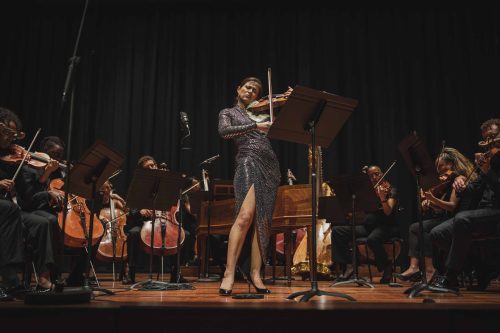 United Kingdom Sowande, Kinoshi, Richter: Rosie Bergonzi (handpan), Elena Urioste (violin), Chineke!. Queen Elizabeth Hall, London, 8.6.2024. (CK)
United Kingdom Sowande, Kinoshi, Richter: Rosie Bergonzi (handpan), Elena Urioste (violin), Chineke!. Queen Elizabeth Hall, London, 8.6.2024. (CK)

Fela Sowande – African Suite
Cassie Kinoshi – To the Hibiscus
Max Richter – The Four Seasons Recomposed
A Baroque-sized Chineke! on Saturday evening – 30 strings, a harp and a harpsichord – in the middle of a five-concert European tour. No conductor: Chi-chi Nwanoku, the orchestra’s founder and principal double bass, made it clear that this was an opportunity they relished, and it certainly served to emphasise the unanimity and excellence of their playing.
Speaking after their performance of Fela Sowande’s African Suite (1955), she affirmed the Nigerian spirit flowing through the music. This was certainly apparent in the spirit rather than the matter: the opening movement – Joyful Day – had a thoroughly English breeziness, with flecks of gold touched in by the harp; and the modal harmonies of Nostalgia inevitably brought our greatest pastoral composer to mind – beautiful, reflective music, with a Tierce de Picardie at the close. In Onipe, a wistful, folksong-like solo violin played against a gently cascading, shimmering veil of strings. Lullaby brought a simple melody on two violas with a rocking pizzicato on cellos and a more prominent role for the harp; in Akinla, the final movement, a bold, rhythmically lively tune with a rather nautical air was handed around the sections to exhilarating effect.
It is attractive music, and it was most attractively played. My elderly and delightful neighbour said it reminded him of Coleridge-Taylor; for me, Finzi came almost immediately to mind. I learned from the programme note that Sowande moved between Nigeria, London and America throughout his life; that his mentors included Edmund Rubbra, and his collaborators included Vera Lynn and John Coltrane. A fascinating, forgotten figure: thank you, Chineke! for doing what you do best, whetting our curiosity and bringing light into dark places.
What followed was, if possible, even more delightful. Cassie Kinoshi’s To the Hibiscus – commissioned by Chineke! and the Southbank Centre – introduced most of the audience (including me) to the handpan: two large shallow metal bowls joined together at the rim, with circular indentations to provide a range of tones: rather like a Trinidadian steel band for a single player, except that the sound – it is played, sometimes barely brushed, by the fingers – is much softer, more like a Gamelan. It was played by Rosie Bergonzi, one of Chineke!’s regular percussionists: just to watch her fingers dancing and flying over the pan – stroking it rather than striking it, it seemed, her body swaying in symbiosis with it – was a joy in itself.
To the Hibiscus – inspired by the Jamaican poet Una Marson – is, in effect, a three-movement, ten-minute concerto for handpan and strings. It opens with lively pizzicato and a carefree melody on violins; the slow movement – for which Rosie used a slightly smaller handpan – is magical, nocturnal, the luminousness of the sound enhanced by a harp; in the exuberant finale the violins and violas become strumming guitars. Much of the music’s enchantment, its aura of weightless celebration, was centred in Rosie herself: it was hard to disagree with Charlotte Barbour-Condini’s words in the programme book about the symbolic meanings of the hibiscus as an emblem of cultural, spiritual, and emotional significance when we could sense these very things springing from Rosie’s fingers as she played. The performance was greeted by a joyfully appreciative standing ovation.

Sometimes we are privileged to witness a special bond between a player and her instrument. Rosie’s improvised solo encore resonated into a rapt silence the like of which I have rarely experienced.
Max Richter’s aim in his Vivaldi’s Four Seasons Recomposed is to rescue us – and it – from its ubiquity as muzak and allow us to hear it with sharpened ears. I am not sure whether notching up three billion Spotify streams means that he has succeeded, or that his version has become muzak alongside the original. It was given a superb performance here, with Elena Urioste the stylish and charismatic soloist (American, but with Basque, Mexican, Sicilian, Russian and Hungarian blood). A few moments of silence (Spring 0) prompt us to recalibrate our expectations before Spring 1 gets under way: and although Vivaldi’s original is never far away – refracted, perhaps, but never distorted – we feel a gravitational pull from other music: John Adams’s Shaker Loops, Arvo Part’s Cantus in Memoriam Benjamin Britten, Copland, Gavin Bryars.
Some of the outer movements are cut off before the expected full close, to keep us on our toes. Richter’s enhancements of Vivaldi are sometimes seductively beautiful – a summer heat-haze conjured by string harmonics and a slow, hypnotic descent on double basses; the addition of a harp edging the continuo cello and harpsichord with gold. A tiny rhythmic displacement ensured that we kept listening to the opening Allegro of Winter; and the removal of rhythmic underpinning in the famous Largo allowed the solo violin to float free, almost like Vaughan Williams’s Lark, against another golden haze of harmonics that brought Caliban to mind – ‘Sometimes a thousand twangling instruments Will hum about mine ears’.
Throughout, there was much to admire in the precision and point of Chineke!’s playing, and in the mutual enjoyment of the music expressed in the easy relationship between soloist, leader and players. Another standing ovation: and perhaps, in Urioste’s Bach encore, elegantly and chastely played, a concession to those in the audience (my neighbour was one) who had mixed feelings about what Richter had done with, or to, Vivaldi.
Chris Kettle
